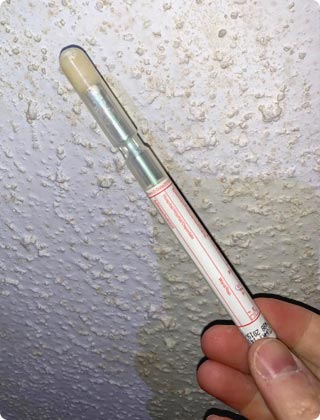MENU


Mold is not only unsightly, but also damaging to the health. However, research shows that at least 70% of homes in the US experience mold growth. Homes are affected by different types of mold, some of which can be very toxic and need professional remediation. No matter the type, the presence of mold can cause an allergic reaction and respiratory issues in some individuals.
Fortunately, there are different types of techniques that mold inspectors and assessors use to test for mold. Our professionals are trained to inspect for mold growth in homes. Mold testing can be mandatory for legal purposes or if you notice symptoms associated with mold.
O2 Mold Testing can conduct different types of mold sample testing services. Here are the different types of mold samples for homes.
Air sampling is a popular mold sampling method used to study indoor air environments. This test can be used to detect and identify the quantified amount of mold spores, which tend to become airborne. Mold air sampling can involve two methods: viable and non-viable.
With the viable method, mold spores are collected on a medium, usually an agar impaction plate. For this air sampling method, the air is checked for spores that are alive for them to grow and be examined. The air samples collected are then incubated to allow the viable particles to germinate, grow, and create a sufficient number of colonies. The colonies are then transferred onto another media, where the species and groups are classified and identified.
The other air mold sampling method is the non-viable method. This method involves collecting spore samples on a filter membrane or a sticky membrane. This can include an allergenco-D cassette or an air-o-cell Air Sampling Cassette.
In order to test for mold, indoor surfaces like building material pieces, dust, tape-lift, and swab samples are tested for the presence of mold spores. Surface samples are collected to determine whether the surfaces of building materials are contaminated by mold and the type of mold.
A downside, however, of using this sample is that it may not be an accurate representation of the actual mold exposure in the building. Hence, this mold sampling method may not be useful when assessing health risks.
This type of mold testing uses different types of materials such as carpet segments and pieces of building materials. This destructive test collects a portion of these materials, which are then transported to the laboratory to determine whether they have mold growth. A small sample is then taken from the bulk sample and cultured for species identification. Alternatively, the sample can be examined via direct microscopy for the identification of the genus.
Usually, the mold assessment begins with a visual inspection by the mold inspector. O2 Mold Testing has trained and licensed mold inspectors that begin by carefully inspecting homes for visual signs of mold in areas like windows, bathroom and kitchen walls, air ducts and vents, and enclosed spaces. This inspection can last between two and six hours.
The inspectors will then take any mold samples collected for a laboratory assessment to determine the presence and type of mold. Typically, the lab analysis can last between 24 and 48 hours. Once we have the results, it will take approximately 2 to 4 business days to write the report and deliver it to you. The turnaround time will vary with the type of sample and the type of laboratory test done.
We understand that you may want to get the results as soon as possible if you have a health concern or when completing a real estate transaction. In this case, we guarantee to give you the report within the next day but at an additional cost.
If you found a mold infestation in your home, there are several things you can do to fix the issue. You first need to hire a licensed mold tester like O2 Mold Testing to test and determine the type of mold. You should get the mold test results within 2 to 4 business days, depending on the type of mold. After testing, you need to call a reputable mold removal team around you.
With very little information about interpreting mold test results, it can be difficult for most people to interpret mold test results. Here is a guide to what should be considered when interpreting mold test results.
Once you have the mold test result, you first want to check the type of mold present so you know what you are dealing with. The most common types of mold that may be found in homes may include:
Also known as black mold, Stachybotrys is a dangerous mold genus that is mostly found in wet materials like cardboard, drywall, and insulation. Stachybotrys chartarum is common in high-cellulose materials like paper, fiberboard, and gypsum board. Black mold can also grow in water-damaged buildings, causing serious structural damage to property. Furthermore, it can cause health issues such as respiratory infections, nausea, headaches, and more, because it produces mycotoxins.
This is a popular mold species that grows in both indoor and outdoor air mold samples. With more than a thousand species, this type of mold is nearly impossible to eliminate. This is also because mold can survive in the air with humidity. This means it can be found even in clean indoor environments.
These molds are allergenic, meaning that they can cause allergic reactions like coughing, skin rashes, and a runny nose. Exposure to large concentrations can also lead to health issues like lung and sinus infections.
This type of mold is found in both outdoor and indoor environments, including in clean and mold-growth-free environments. It has a dark green or black appearance and can cause allergic reactions or asthma in some people. Mostly, you will find this allergenic mold in wood, fiberglass, and painted surfaces.
A common mold found outdoors can be found in damp, wooded, and shady areas. Although very rare, this mold type can grow indoors on wet surfaces. It is produced by fungi-like mushrooms and can cause structural damage to buildings.
This type of mold is usually found in water-damaged cellulose materials as is the case with Stachybotrys. Similarly, it is very dangerous since it produces mycotoxins, which can cause health issues and structural damage to homes.
Chaetomium is an allergenic mold linked to allergic reactions in some people. This is because it produces mycotoxins, which can be toxic. Chaetomium globosum often grows in water-damaged buildings. This mold can also be found in wet carpets, drywalls, and insulations. This mold type spreads quickly and can cause great structural damage. Hence, immediate action is needed once this mold is detected.
Something else that your mold test should indicate is the concentration of mold spores in the air. If the air quality testing shows mold concentration below 500 sp/m³, you may not need remediation as this level is considered low and clean. If the report shows levels between 501 and 1500 sp/m³, cleaning and wiping surfaces may be necessary to remediate the mold present.
However, you may need to take immediate action for mold concentration levels above 1500 sp/m³. The higher the levels, the more mold clean-up is required and the need for a professional mold remediator. Otherwise, prolonged exposure can lead to severe health problems.
With the test results, you can identify the areas where there are concentrations of the mold samples. The report will help you locate these areas so you can take action to effectively remediate the problem.
The report will also include specific recommendations that you can take to remediate the problem. If the source of the problem is widespread, O2 Mold Testing will help you take immediate action to clean the affected areas and remove the material affected by mold to prevent it from spreading.
To prevent mold growth in your home, keep the humidity levels low, keep the house dry, and remove soaked carpets and upholstery after a flood. Also, make sure that you fix any leaks, wash the bathroom with mold-killing products, and use exhaust fans and humidifiers in areas prone to mold.
If you suspect indoor mold growth, hire our professional mold testing services to identify the source and type of mold. On a regular basis, you can perform a visual inspection on mold-prone areas like the bathroom, basements, and roofs for any signs of mold.
Yes, most licensed home inspectors are trained to examine and identify mold in homes and other buildings. However, unlike mold inspectors, home inspectors may not provide mold reports or offer remediation for mold issues since it is beyond their scope of work. For this reason, it is safer to hire a professional mold inspection and testing company to obtain a complete plan called a mold remediation protocol.
A mold inspector needs to wear Personal Protective Equipment (PPE), including a mask, it they are engaging in any direct contact with the mold. This is because mold spores are airborne and can float and detach everywhere when disturbed. A respiratory mask can help protect against inhalation of small mold spores through the nose or mouth.
So, for professional mold inspection and testing services, look no further than O2 Mold Testing. Not knowing which type of mold infestation is in your home can be stressful, and we are here to help you test professionally. We pride ourselves on doing a thorough job that will give you peace of mind.
All our technicians are well-experienced and trained to use state-of-the-art technology to inspect properties for hidden mold and provide quality mold testing. If you are uncertain about mold in your home, give us a call today and we will be glad to inspect your home and offer the right mold services at an affordable price.